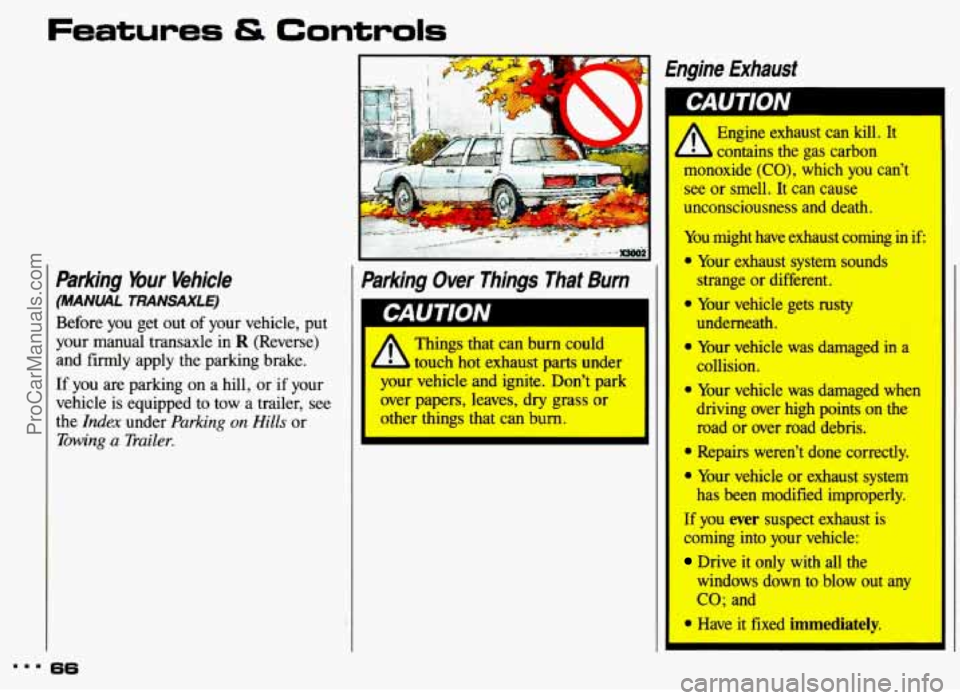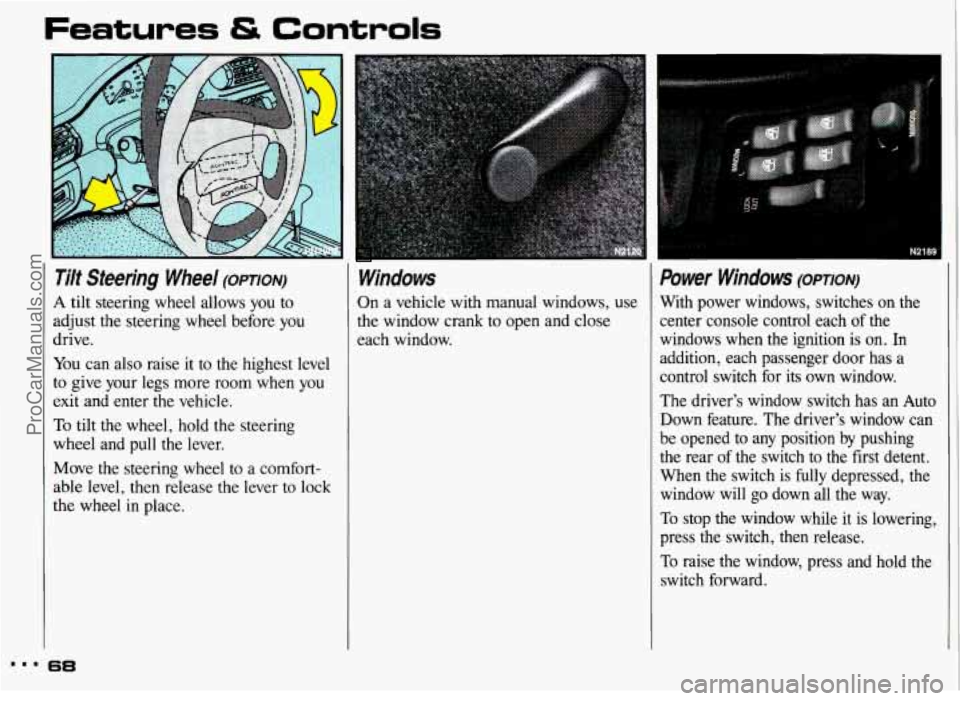Page 7 of 306
How to Use this Manual
Vehicle Symbols (CONT.:)
These symbols are on some of your
controls:
Windshield Wipers
Windshield Washer
Windshield Defroster
Rear Window Defogger
Ventilating Fan
Power Window
These symbols are used on warning and
Here are some other symbols you may
indicator lights: see:
Engine Coolant
Temperature
Battery Charging
System
Fuel
Engine Oil Pressure
Brake
Anti-Lock Brakes Fuse
(0)
Speaker
(@I
Hood Release
... 6
ProCarManuals.com
Page 24 of 306
Rear Seat Passengers
It's very important for rear seat
passengers to buckle
up! Accident
statistics show that unbelted people
in
the rear seat are hurt more often in
crashes than those who are wearing safety belts.
Rear passengers who aren't safety belted
can be thrown out
of the vehicle in a
crash. And they can strike others in the
vehicle who are wearing safety belts.
Rear Seat Outside Passenger
Positions
The positions next to the windows have
lap-shoulder belts.
Here's How to Wear One Properly:
1. Pick up the latch plate and pull the
belt across
you. Don't let it get
twisted.
2. Push the latch plate into the buckle
until it clicks.
23
ProCarManuals.com
Page 39 of 306
Seats & Safety 6elts
Larger Children
Children who have outgrown child
restraints should wear the vehicle's
safety belts.
If you have the choice, a child should sit
next to a window
so the child can wear
a lap-shoulder belt and get the
additional restraint a shoulder belt can
provide.
Accident statistics show that children are
safer
if they are restrained in the rear
seat. But
they need to use the safety
belts properly.
Children who aren't buckled up can be
thrown out
in a crash.
Children who aren't buckled up can
strike other people who are.
2061 -
Never do this.
A Here two children are wearing
the same belt. The belt can't
properly spread the impact forces.
In a crash, the two children can be
crushed together and seriously injured. A belt must be used by
only one person at
a time. I
msm 38
ProCarManuals.com
Page 44 of 306

Here you can learn about the
many standard and optional features
on your Pontiac. and information on
starting. shifting and braking
. Also
explained are the instrument panel
and the warning systems that tell
you
if everything is working
properly-and what to do
if you have
a problem
.
Part 2
Features & Controls
Keys .............................. ............................ 44
GloveBox ....................................................... 50
StartingYourEngine
............................................... 52
LOC
ks ........................................................... 45
Ignitionswitch
.................................................... 51
Engine Block Heater
............................................... 56
Shifting the Transaxle
.............................................. 57
ShiftingIntoPark
.................................................. 64
Turn SignaVHeadlight Beam Lever .................................... 69
Cruisecontrol .................................................... 70
Lightcontrols
.................................................... 74
Interior Lights
.................................................... 76
Windshield Wipers
................................................. 79
Windshield Washer ................................................ 80
Mirrors .......................................................... 81
Ashtray and Lighter ................................................ 85
Warning Lights, Gages and Indicators .................................. 91
ParkingBrake
.................................................... 63
Windows
........................................................ 68
Sunvisors
....................................................... 82
InstrumentPanel
.................................................. 86
ProCarManuals.com
Page 45 of 306
Features & Controls
Keys
P
.~eaving young children in a‘
vehicle with the ignition key
is dangerous for many reasons. A
child or others could be badly
injured. or even killed.
They could operate power
windows or other controls or even
make the vehicle move.
Don’t leave the keys in a vehicle
with young children. The
ignition keys are for the ignition
only.
The door keys are for the doors and all
other locks. {hen
a new Pontiac is delivered, the
:aler removes the plugs from the keys,
Id gives them to the first owner.
ach plug has a code on it that tells your
:aler or a qualified locksmith how to
lake extra keys. Keep the plugs in a
lfe place.
If you lose your keys, you’ll
; able to have new ones made easily
sing these plugs.
... 44
ProCarManuals.com
Page 50 of 306
Parking at Night: Park in a lighted
spot, close all windows and lock your
vehicle. Remember to keep your valuables out of sight. Put them in a
storage area, or take them with you.
Parking Lots: If you park in a lot where
someone will be watching your vehicle,
it’s best to lock it up and take your keys.
But what if you have to leave your
ignition key? What if you have to leave something valuable in your vehicle?
Put your valuables in a storage area,
Activate the remote trunk release
Lock the glove box.
Lock all the doors except the driver’s.
Then take the door key with you.
like your trunk
or glove
box.
lockout feature.
Trunk Lock
To unlock the trunk from the outside,
insert the door key and
turn the trunk
lock cylinder.
Remote Trunk Release
Pull upward on the remote release
handle, located on the floor near the left
side of the driver’s seat, to release the
trunk lid. Make sure the lockout feature
is not activated.
ProCarManuals.com
Page 67 of 306

Features & Controls
Parking Your Vehicle
(MANUL TRANSAXLE)
Before you get out of your vehicle, put
your manual transaxle in
R (Reverse)
and firmly apply the parking brake.
If you are parking on a hill, or if your
vehicle
is equipped to tow a trailer, see
the Index under Parking on Hills or
i%w*ng a Trailer.
36
1 Engine Exhaust
I
Parking Over Things That Burn
Things that can burn could
touch hot exhaust parts under
your vehicle
and ignite. Don’t park
over papers, leaves, dry grass or
other things that can burn.
Engine exhaust can kill. It
contains the gas carbon
monoxide
(CO), which you can’t
see or smelt It can cause
unconsciousness and death.
You might have exhaust coming
in if:
* Your exhaust system sounds
strange or different.
* Your vehicle gets rusty
undemath.
* Your vehicle was damaged in a
collision.
* Your vehicle was damaged when
driving over high points on the
road or over road debris.
* Repairs weren’t done correctly.
* Your vehicle or exhaust systkm
has been modified improperly.
If you eys suspect exhaust is
~rrmi@ into your vehicle:
Drive it only wifh all the
windows down to blow out any
co; and
* Have it -fixed immediately.
ProCarManuals.com
Page 69 of 306

...
Features & Controls
Ti/t Steering Wheel (opTIoN)
A tilt steering wheel allows you to
adjust the steering wheel before you
drive.
You can also raise it to the highest level
to give your legs more room when
you
exit and enter the vehicle.
To tilt the wheel, hold the steering
wheel and pull the lever.
Move the steering wheel to a comfort-
able level, then release the lever to lock
the wheel in place.
38
Windows
On a vehicle with manual windows, use
the window crank to open and close
each window.
I N21
Power Windows (opTIoN)
With power windows, switches on the
center console control each of the
windows when the ignition is
on. In
addition, each passenger door has a
control switch for its own window.
The driver’s window switch has an Auto
Down feature. The driver’s window can
be opened to any position by pushing
the rear of the switch to the first detent.
When the switch is fully depressed, the
window will go down all the way.
To stop the window while it
is lowering,
press the switch, then release.
To raise the window, press and hold the
switch forward.
ProCarManuals.com